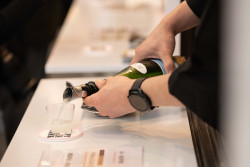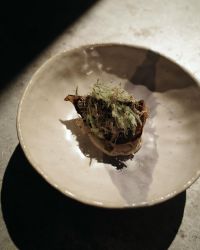
Originally published on metropolis.co.jp on December 2007
The leafy, upscale neighborhood of Kita-Aoyama is renowned for many things, but a vibrant nightlife scene is not one of them. The area’s cafes, boutiques, galleries and shops draw well-heeled shoppers and sightseers—all of whom seem to head elsewhere once the sun goes down.
So it was with a certain amount of trepidation that we made our way to Harem on a recent Saturday night. Walking over from nearby Gaienmae station, our voices and footsteps echoed through the Aoyama’s wide thoroughfares and sleepy plazas. We only hoped to be spared the special brand of discomfort that comes from being a restaurant’s only customers.
What a surprise, then, to walk into Harem and find a nearly full house. A genki international crowd made up of groups and couples created a welcoming buzz, while the narrow interior gave the underlit space an air of intimacy. Bench seats along one wall are matched by a series of two- or four-person tables opposite the long front window, and a vividly colored arch motif graces the wall and various pieces of décor. Effortlessly stylish and thoroughly unstuffy, Harem would be both a fantastic date spot and venue for small parties.
We started off with an order of the restaurant’s original cocktails, the Uludag (yogurt liqueur and orange juice) and the “Mediterranean Sea Breeze” (both ¥850). Our choice of food was easy: the ¥5,000 course dinner, discounted to ¥4,000 because of a coupon we found online.
The meal got off to a wonderful start with karisik ezme—mixed appetizer dips with Turkish white cheese. We were able to choose four varieties of puréed goodness from a list that included hummus, spinach-yogurt, spicy yogurt with mint, chicken paste with walnut, tomato-parsley, and carrot with walnut and yogurt (à la carte, three for ¥1,600 or four for ¥1,900). Served with soft, warm ekmek bread (¥300) and a hard, salty, feta-like wedge of white cheese, the dips were uniformly delicious. Our only complaint was the tiny portions, which looked like they’d been served up with a large thimble.
The next chilled appetizer—a cube-shaped wedge of sautéed eggplant topped by layers of tomato sauce, yogurt and basil (¥1,400)—turned out to be our favorite dish of the evening, thanks to its simple, honest flavors and contrasting textures. A fresh but ordinary vegetable salad (¥1,050) followed, and then the robust begendi, which is hot eggplant purée with seared tuna (¥1,700). We particularly enjoyed the feta-cheese pide that came next, described on the menu as “Turkish pizza” but more reminiscent of a calzone. The main dish, an assortment of lamb and chicken kebabs, were perfectly cooked and spiced, and went extremely well with a bottle of Harem’s house white wine from Turkey, Antik (¥4,500).
One of our more trustworthy colleagues describes Harem as his favorite Tokyo restaurant. Although we wouldn’t go that far, after just one visit, we can understand why he would think so.









